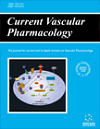- Home
- A-Z Publications
- Current Vascular Pharmacology
- Previous Issues
- Volume 20, Issue 6, 2022
Current Vascular Pharmacology - Volume 20, Issue 6, 2022
Volume 20, Issue 6, 2022
-
-
Association Between Telomere Length and Cardiovascular Risk: Pharmacological Treatments Affecting Telomeres and Telomerase Activity
More LessTelomeres represent the ends of chromosomes, and they are composed of an extensive number of – TTAGGG nucleotide sequence repeats in humans. Telomeres prevent chromosome degradation, participate in stabilization, and regulate the DNA repair system. Inflammation and oxidative stress have been identified as important processes causing cardiovascular disease and accelerating telomere shortening rate. This revie Read More
-
-
-
Patients with Polyvascular Disease: A Very High-risk Group
More LessAuthors: Antonis A. Manolis, Theodora A. Manolis and Antonis S. ManolisPolyvascular disease (PolyvascDis) with atherosclerosis occurring in >2 vascular beds (coronary, carotid, aortic, visceral and/or peripheral arteries) is encountered in 15-30% of patients who experience greater rates of major adverse cardiovascular (CV) events. Every patient with multiple CV risk factors or presenting with CV disease in one arterial bed should be assessed for PolyvascDis clinically and noninvasively prior to invasive Read More
-
-
-
Comparison of Efficacy and Safety between Thrombolysis Plus Anticoagulation vs. Anticoagulation Alone for the Treatment of Acute Submassive Pulmonary Embolism: A Systematic Review and Meta-analysis
More LessAuthors: Qingyun Pan, Han Gao, Yingju Wang and Quanfang ChenObjective: The objective of this study is to compare the efficacy and safety of thrombolysis plus anticoagulant therapy vs. anticoagulant therapy alone in acute submassive pulmonary embolism (PE). Materials and Methods: The PubMed, Embase, and Cochrane Library databases were searched for randomized clinical trials comparing thrombolytic therapy and anticoagulation vs. anticoagulation alone in acute submassiv Read More
-
-
-
The Relation Between Red Blood Cell Distribution Width and Coronary Atherosclerotic Plaque Vulnerability Detected by Intracoronary Optical Coherence Tomography
More LessAuthors: Peng Jin, Si-Jing Wu, Qian Ma, Wei Liu, Ying-Xin Zhao, Hong-Ya Han, Fang-Jie Hou, Ya Li and Yu-Jie ZhouBackground: A higher red blood cell distribution width (RDW) predicts major adverse cardiac events in patients with coronary artery disease (CAD). However, there are only a few studies regarding the relationship between RDW and vulnerable plaques. Thus, the purpose of the present study is to retrospectively explore the predictive value of the association between RDW and plaque vulnerability assessed by optical coherence tom Read More
-
-
-
Prognostic Value of Pericardial Effusion Size in Patients with Acute Heart Failure
More LessAuthors: Guangyao Zhai, Biyang Zhang, Jianlong Wang, Yuyang Liu and Yujie ZhouBackground: Pericardial Effusion (PEf) can occur with Acute Heart Failure (AHF). Objective: To evaluate the effect of PEf size on the prognosis of patients with AHF. Methods: According to the maximum size of PEf, all patients were divided into five groups. The primary outcome was in-hospital mortality. The independent effect of PEf size was determined by binary logistic regression analysis. The curve in line with the overall tren Read More
-
-
-
Efficacy and Safety of Direct Oral Anticoagulants in the Treatment of Left Ventricular Thrombus After Acute Anterior Myocardial Infarction in Patients Who Underwent Percutaneous Coronary Intervention
More LessAuthors: Jing Liang, Zhijian Wang, Yujie Zhou, Hua Shen, Meng Chai, Xiaoteng Ma, Hongya Han, Qiaoyu Shao and Qiuxuan LiAims: To explore treatment with Direct Oral Anticoagulants (DOACs) in left ventricular thrombus (LVT) after ST-segment elevation myocardial infarction (STEMI) in patients who underwent percutaneous coronary intervention (PCI). Background: Contemporary data regarding using DOACs for LVT after STEMI patients who underwent PCI is limited. Objectives: To investigate the efficacy and safety of DOACs on the treatment Read More
-
-
-
Tadalafil Improves Haemodynamics and Arterial Stiffness but Not Flow- Mediated Dilation in Grade 1 Obesity. A Single-dose, Placebo-controlled Clinical Trial
More LessObjective: Obesity, a major health issue worldwide, is associated with increased cardiovascular risk, endothelial dysfunction, and arterial stiffness. Tadalafil has been demonstrated to improve vascular parameters. Aim: To evaluate the effect of a single 20 mg dose of tadalafil on flow-mediated dilation and hemodynamic and arterial stiffness markers. Methods: A randomized, double-blind, placebo-controlled study was conducted Read More
-
Volumes & issues
-
Volume 23 (2025)
-
Volume 22 (2024)
-
Volume 21 (2023)
-
Volume 20 (2022)
-
Volume 19 (2021)
-
Volume 18 (2020)
-
Volume 17 (2019)
-
Volume 16 (2018)
-
Volume 15 (2017)
-
Volume 14 (2016)
-
Volume 13 (2015)
-
Volume 12 (2014)
-
Volume 11 (2013)
-
Volume 10 (2012)
-
Volume 9 (2011)
-
Volume 8 (2010)
-
Volume 7 (2009)
-
Volume 6 (2008)
-
Volume 5 (2007)
-
Volume 4 (2006)
-
Volume 3 (2005)
-
Volume 2 (2004)
-
Volume 1 (2003)
Most Read This Month
Article
content/journals/cvp
Journal
10
5
false
en


